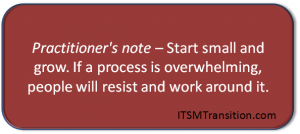Your boss says he wants you to implement IT Change Management. Google it (which is probably why you’re reading this now) and you get countless pages of mind numbing details. What do I do? Where do I even start?
Where to Start with IT Change Management
First of all, don’t panic. You’re in the right place. You can do this, and come out unscathed. Might even end up with a kudo or two for your effort.
The problem with all that google’d information is that it’s mostly vendors and consultants who live and breathe this stuff. Which is great, and you can learn a lot – but you need something now. Something you can actually achieve, in your company, and show value quickly.
Here’s how I did it recently at a relatively small organization (about 1,000 employees)
Let’s do this thing
Change Management really boils down to a few basic elements:
- Rapidly implementing business-required changes
- Managing Risks
- Maximize business value
- Minimize likelihood and impact of unintended consequences
It comes down to improving results in the eyes of the business. So, ask them. How IT can improve?
Understand the Business Value of Change Management
Do your homework. Understand the needs and pain points of the business you serve. I’m betting there are recent cases where Change Management would have avoided pain for the business. (Chances are good that’s why the boss wants Change Management)
Use those cases to get them engaged in what you’re trying to do. Talk more about improvements to service and business value, and very little about “Change Management”.
Be ready to give your “elevator speech” at any time. Know the specific ways you intend to improve around changes, and talk about that. Hint – avoid IT-ish words like ‘process’, ‘Change Management’, and ‘Incident’. NEVER say “CMDB” (Configuration Management Database)
Get People on Board
Do not underestimate the importance of getting people on board. As soon as you start thinking about Change Management, start talking with people about it. Rehearse your elevator speech everywhere you go, and then shut up and listen. Get them to talk about their needs, fears and doubts. What do they need? Why do they think it won’t work? (or will work?)
Build relationships. Listen to people.
Never say ‘the boss wants me to implement…’ If you don’t believe it’s a good thing, they never will. Focus on how it will improve the quality of IT services. How changes will be implemented more quickly, and with less problems.
Implement a Basic Change Management Process
Start with a very basic Change process that fits with the culture. Two very popular posts are How to Implement Basic IT Change Management and How to Mature a Basic IT Change Management Process.  Use these to get started. Don’t reinvent the wheel – adapt them as needed.
Use these to get started. Don’t reinvent the wheel – adapt them as needed.
Start small and grow. By implementing a Basic Change Management process, you can deliver value very quickly and start building support. If the process is overwhelming, people will resist and work around it.
Let me say it again – start small. Leave room for early adopters to have ideas about how to improve it. This is exactly what you want – buy in. Ownership.
What about a tool? For getting started, it’s important to get business value quickly. You can do a lot with a basic process and no tools. Get the process down first. Don’t get distracted by tools. You’ll know much better what kind of tool you need with some experience under your belt.
Plan for Version Two
Be on the look out for improvements to incorporate in the next version. Keep a list of ideas, and set a date for releasing “version two”. It’s best to group improvements so people aren’t confused by constant minor changes. Keep it as clear as possible – this is version one. In version two, we will…
Ready?
That’s pretty much it. Here you have a proven guide to implementing Basic IT Change Management.
You’re not alone in this. Here’s Five Lessons I Learned Implementing IT Change Management.
You might also be interested in How to Measure a Basic IT Change Management Process.
If you have questions along the way, why not drop me an email, or follow me on twitter?
Photo Credit